Affordable All-Inclusive Resort in Limone sul Garda
ITWPA Member
Limone sul Garda is a true Italian gem that will steal your heart. It lies 27 miles northwest of Verona and 80 miles west of Milan and is one of the most photogenic villages on Lake Garda.
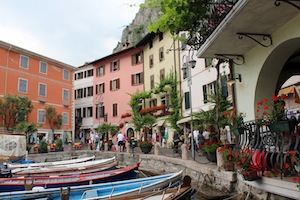 The houses along the harbor front are painted vibrant shades of pink, green, orange, and yellow. The restaurant terraces are bordered by pink laurel flower pots and palm trees, and some even extend over the water on wooden stilts, complete with lanterns and bright red pots of geraniums.
The houses along the harbor front are painted vibrant shades of pink, green, orange, and yellow. The restaurant terraces are bordered by pink laurel flower pots and palm trees, and some even extend over the water on wooden stilts, complete with lanterns and bright red pots of geraniums.Indeed, there are so many flowers along Lake Garda that their delicate fragrances linger in the air. The food stalls which line the narrow cobbled streets are a feast for the eyes as much as for the palate, with their ripe fruits perfectly aligned in little wooden boxes. In Italy, where life hands out some of the biggest lemons you will ever see, locals don’t just make lemonade -- they make limoncello (a popular digestive liqueur best served chilled).
Many boats come and go, linking the various towns across the lake (all picturesque in their own rights). Even the cars seem to go at a slower pace, making driving for non-Italians a lot easier than it would be further south!
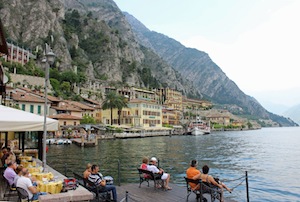 The nearest airport is Verona (where Romeo and Juliet fell in love); to reach Limone, you need to drive a good hour and 40 minutes on the A22. The airport does have a car rental office -- although renting a Peugeot 206 for a week, including full insurance, will set you back $428. Drive towards Brennero-Modena and take the Rovereto-Lago di Garda Nord exit, then follow directions to Lago di Garda and Riva del Garda.
The nearest airport is Verona (where Romeo and Juliet fell in love); to reach Limone, you need to drive a good hour and 40 minutes on the A22. The airport does have a car rental office -- although renting a Peugeot 206 for a week, including full insurance, will set you back $428. Drive towards Brennero-Modena and take the Rovereto-Lago di Garda Nord exit, then follow directions to Lago di Garda and Riva del Garda. One of the best value for money resorts in the area has to be the four star Leonardo Da Vinci Hotel. At $94 per person (off-peak) all inclusive (and read this to mean: all soft drinks, wine, beer, and liquor), you would be hard pressed to find better value. The staff are not only gracious but multi-lingual, and the superior rooms are spacious with balconies overlooking the lake and mountains. There are three large pools, including one with slides for kids and one indoors for rainy days. They even have a little shuttle that heads hourly into Limone to save you the steep parking fees or the 15 minutes’ walk.
The three meals per day are all based on “as much as you can eat” though the dinner buffet is the most lavish. There is plenty of choice for vegetarians, and lovely, tender meat and fish for those who are not. If you have a sweet tooth chances are you will be tempted to try out every dessert: fruit tarts, chocolate cakes, tiramisu, panna cotta… not to mention the many flavors of those world-famous Italian ice creams. Not only was the food truly gourmet (and let’s face it, delicious food has got to be one of the highlights of any holiday) but because it’s cooked in olive oil it is really healthy, too. In fact, we didn’t put on half the weight we had expected to, considering how much we did indulge!
Last but not least: Limone sul Garda is 2 hours and 45 minutes from atmospheric Venice and just 2 hours from the Dolomites National Park with its alpine mountains and dazzling turquoise lakes. The Leonardo Da Vinci Hotel can also book excursions to the many regional “must-see” locations at around $61-$83 per day (cash only), a welcome break from driving, leaving you free simply to enjoy the peaceful scenery.
La dolce vita? You bet.
If you’d like to purchase this article for your publication, click here to contact the author directly.
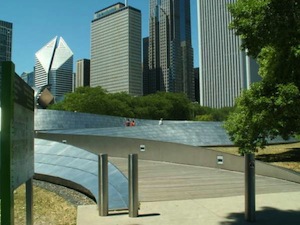 It’s a hot summer day. You’ve spent the morning shopping along the Magnificent Mile, or perhaps you were museum hopping or just taking in the city’s sights. Now you are warm and hungry, and your feet are tired and sore. You are ready for a break. Head to Millennium Park, where art meets park, to enjoy a meal, relax, and maybe even cool your feet in a fountain.
It’s a hot summer day. You’ve spent the morning shopping along the Magnificent Mile, or perhaps you were museum hopping or just taking in the city’s sights. Now you are warm and hungry, and your feet are tired and sore. You are ready for a break. Head to Millennium Park, where art meets park, to enjoy a meal, relax, and maybe even cool your feet in a fountain.  For more stainless steel art, don’t miss the iconic Cloud Gate (better known as The Bean because of its kidney bean shape), a sculpture by Amish Kapoor. Tourists often surround The Bean, cameras in hand, snapping pictures of the brilliant reflections of themselves and the city’s skyline in this highly polished sculpture in the center of the park’s plaza.
For more stainless steel art, don’t miss the iconic Cloud Gate (better known as The Bean because of its kidney bean shape), a sculpture by Amish Kapoor. Tourists often surround The Bean, cameras in hand, snapping pictures of the brilliant reflections of themselves and the city’s skyline in this highly polished sculpture in the center of the park’s plaza.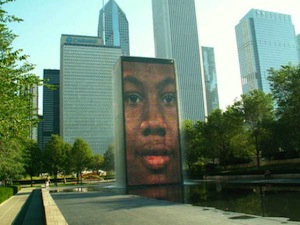 If you feel conspicuous frolicking in the pool of the Crown Fountain, make your way to the canal at the Lurie Garden instead. No more than three feet wide and a few inches deep, the canal that runs the length of the Lurie Garden adjacent to the boardwalk is a perfect spot to sit and dangle your feet in the water while you plan your afternoon. When you have cooled off and are rested, take a walk through the two-and-a-half-acre garden with over 138 varieties of perennial plants. You can take a guided tour of the garden at midday on summer Fridays and Sundays.
If you feel conspicuous frolicking in the pool of the Crown Fountain, make your way to the canal at the Lurie Garden instead. No more than three feet wide and a few inches deep, the canal that runs the length of the Lurie Garden adjacent to the boardwalk is a perfect spot to sit and dangle your feet in the water while you plan your afternoon. When you have cooled off and are rested, take a walk through the two-and-a-half-acre garden with over 138 varieties of perennial plants. You can take a guided tour of the garden at midday on summer Fridays and Sundays.  In the midst of rolling green countryside near Münstermaifeld, Germany, sits a castle that would fulfill many a young girl’s dreams of where she, the princess that she is, should live. This mesmerizing castle, hidden in a valley away from view from the roads above, is the medieval castle Burg Eltz (or Eltz Castle).
In the midst of rolling green countryside near Münstermaifeld, Germany, sits a castle that would fulfill many a young girl’s dreams of where she, the princess that she is, should live. This mesmerizing castle, hidden in a valley away from view from the roads above, is the medieval castle Burg Eltz (or Eltz Castle).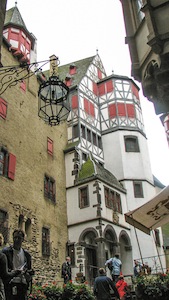 Representing the family’s 33rd generation, the current owner, Dr. Karl Graf von und zu Eltz (also known as Faust von Stromberg), resides full time elsewhere in Germany with his wife and children. However, the family actively uses the castle, adding their own personal touches such as family photos and flower arrangements created by the current duchess herself with flowers from her own gardens.
Representing the family’s 33rd generation, the current owner, Dr. Karl Graf von und zu Eltz (also known as Faust von Stromberg), resides full time elsewhere in Germany with his wife and children. However, the family actively uses the castle, adding their own personal touches such as family photos and flower arrangements created by the current duchess herself with flowers from her own gardens. 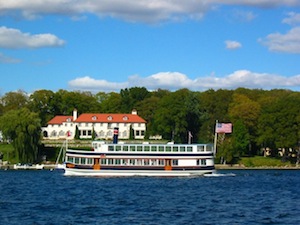 Savor your summer with a tasty combination of three of the season’s perennial pleasures in Fontana, Wisconsin. “Burnin’ Down the Docks” is a Sunday celebration of “Blues, Brews & BBQ” at The Abbey Resort, right on the picturesque Lake Geneva harbor.
Savor your summer with a tasty combination of three of the season’s perennial pleasures in Fontana, Wisconsin. “Burnin’ Down the Docks” is a Sunday celebration of “Blues, Brews & BBQ” at The Abbey Resort, right on the picturesque Lake Geneva harbor.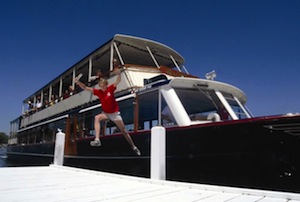 If you go for the long weekend, the surrounding area offers much to see and do, plus a fascinating history of millionaires and mobsters. We got an excellent overview on one of the hour-long steamboat tours of Lake Geneva, the second largest lake in Wisconsin. I wanted ice cream, my husband wanted beer, and we both got our way on the Ice Cream Social Tour. On the famous Mailbox Tour, a college student makes an athletic leap from boat to pier to deliver residents’ mail. The boat never stops, so the trick is to hop off and back on in time -- to much applause. I really loved the dog who waits for the mail on the pier, takes it in his mouth, and delivers it up to the house.
If you go for the long weekend, the surrounding area offers much to see and do, plus a fascinating history of millionaires and mobsters. We got an excellent overview on one of the hour-long steamboat tours of Lake Geneva, the second largest lake in Wisconsin. I wanted ice cream, my husband wanted beer, and we both got our way on the Ice Cream Social Tour. On the famous Mailbox Tour, a college student makes an athletic leap from boat to pier to deliver residents’ mail. The boat never stops, so the trick is to hop off and back on in time -- to much applause. I really loved the dog who waits for the mail on the pier, takes it in his mouth, and delivers it up to the house.